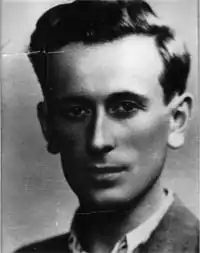Edmund Roman Orlik | |
|---|---|
 | |
| Born | January 26, 1918 Rogoźno, Poland |
| Died | April 8, 1982 (aged 64) Opole, Poland |
| Allegiance | |
| Service/ | Polish Army (1937–1939) |
| Rank | |
| Unit | 71st Armored Unit |
| Awards | Cross of Valour (Poland) |
| Other work | architect |
Edmund Roman Orlik (26 January 1918 – 8 April 1982)[1] was a Polish architect, and World War II tank commander. During the Invasion of Poland by Nazi Germany in September 1939 he claimed to have destroyed ten German tanks, including one Panzer IV Ausf. B, the largest tank then fielded by Germany, with a 2.6 tonne TKS tankette armed with a 20mm autocannon.[2][3]
Early life
Orlik was born on 26 January 1918. After graduating high school he volunteered for military service and completed his training in Armoured Warfare Training Centre (Centrum Wyszkolenia Broni Pancernych) in Modlin in 1937. Then he began to study Architecture at the Warsaw Polytechnic.[4]
World War II


In August 1939 he was mobilized and took part in the September Campaign in the 71st Polish Armored Squadron as a Podchorąży (officer cadet). On 18 September 1939, Orlik took part in the skirmish of Pociecha in the Kampinos Forest, in which three TKS tankettes destroyed three German tanks, two Panzer 35(t)s and a Panzer IV Ausf. B, from the 1. Leichte Division.

As a result of the battle the commander of the German platoon and heir to the Duchy of Racibórz, 23-year-old Silesian prince and lieutenant Viktor IV Albrecht Johannes von Ratibor, who rode in the Panzer IV, was killed.[4][3] There is an established version, coming from Janusz Magnuski's works, based solely on Orlik's accounts, that only Orlik's tankette had a 20mm cannon; the others were equipped with machine-guns, and Orlik destroyed all three tanks.[2] However, there are other sources, that all three Polish TKS were armed with 20mm cannons.[5] Moreover, a history of Polish armoured weapons written in 1971 in London does not mention Orlik, listing three other participants of the skirmish at Pociecha out of six Polish tankers (names: Tritt, Pachocki and Łopatka).[6]
The next day Orlik and his unit participated in the battle of Sieraków. During the night, the Germans were repelled by the Polish 9th Uhlan Regiment and 7th Mounted Rifles. However, the Germans counter-attacked with several dozen tanks from the Panzer-Regiment 11 and Panzer-Abteilung 65. During the battle, Orlik claimed to have destroyed seven tanks with his TKS and took two German tank crewmen prisoners with his service pistol. The Polish forces managed to destroy 20 tanks with artillery support.[2] After the battle, he and his unit retreated east and took part in the Siege of Warsaw.
During the Occupation of Poland (1939–45) Orlik was a member of the Home Army.
Post-war architectural career
After the war Orlik returned to his pre-war studies, after graduating from the Visual Arts College (Wyższa Szkoła Plastyczna) he was employed as an architect in Łódź. He designed the Łódź University Library, built between 1956-1960, and considered to be one of the most elaborate architectural work in the city during the Polish People's Republic era.[7] Orlik also designed the dormitory for foreign students (nicknamed the Tower of Babel) and the Department of Foreign Languages building. He eventually completed his architectural studies at the Wrocław University of Technology and from the beginning of the 1970s, resided and worked in Opole.
Death
He died by car accident on 8 April 1982.
Memorial
In Pociecha, where the battle was fought, a memorial stone dedicated to Orlik was erected. (Located at 52°20′02″N 20°44′15″E / 52.33389°N 20.73750°E).[8]
Awards
Popular culture references
In the video game World of Tanks, the Orlik's Medal is awarded for destroying two or more enemy tanks or tank destroyers with a light tank. The targets must be at least one tier higher than the player's tank. The game also features the TKS as a playable vehicle.
Further reading
- Michał Derela. "Polish tankettes TK-3 and TKS. Part IV: Tankettes with 20 mm cannons". Retrieved 2019-04-11.
- warisboring.com (25 July 2018). "How a Lone Polish Cadet Rampaged Through German Panzers". Retrieved 2019-03-10.
- zgzeirp.pl. "ORLIK EDMUND ROMAN. NAJLEPSZY POLSKI PANCERNIAK W II WOJNIE ŚWIATOWEJ" (in Polish). Archived from the original on 2018-05-26. Retrieved 2015-04-05.
- facet.interia.pl. "Roman Orlik - pierwszy polski as pancerny" (in Polish). Archived from the original on 2015-12-22. Retrieved 2015-04-05.
- polskaniezwykla.pl. "Książęce śmierci" (in Polish). Retrieved 2015-04-05.
- bohaterowie1939.pl. "Karta weterana: Edmund Roman Orlik" (in Polish). Retrieved 2019-03-10.
{{cite web}}: CS1 maint: numeric names: authors list (link) - wotinfo.hu. "World of Tanks magyar portál - Kitüntetések" (in Hungarian). Retrieved 2015-04-05.
References
- ↑ "Orlik Edmund Roman". Archived from the original on 2018-05-26. Retrieved 2015-12-16.
- 1 2 3 Janusz Magnuski: Karaluchy przeciw panzerom. Warszawa: Pelta, 1995. ISBN 83-85314-06-7.
- 1 2
- warisboring.com (25 July 2018). "How a Lone Polish Cadet Rampaged Through German Panzers". Retrieved 2019-03-10.
- 1 2 Janusz Magnuski: Orlik uderza pierwszy in: "Za Wolność i Lud" nr 20/1978, p.15
- ↑ Rajmund Szubański: Pancerne boje września, ZP Grupa, 2009, ISBN 978-83-61529-29-3, p.133-134
- ↑ Marian Żebrowski: Zarys historii polskiej broni pancernej, London, 1971, p.297.
- ↑ "Łódź: Jak z PRL, to nie znaczy do wyburzenia". 30 July 2010.
- ↑ "Ołtarzew - Książęce śmierci. Atrakcje turystyczne Ołtarzewa. Ciekawe miejsca Ołtarzewa".